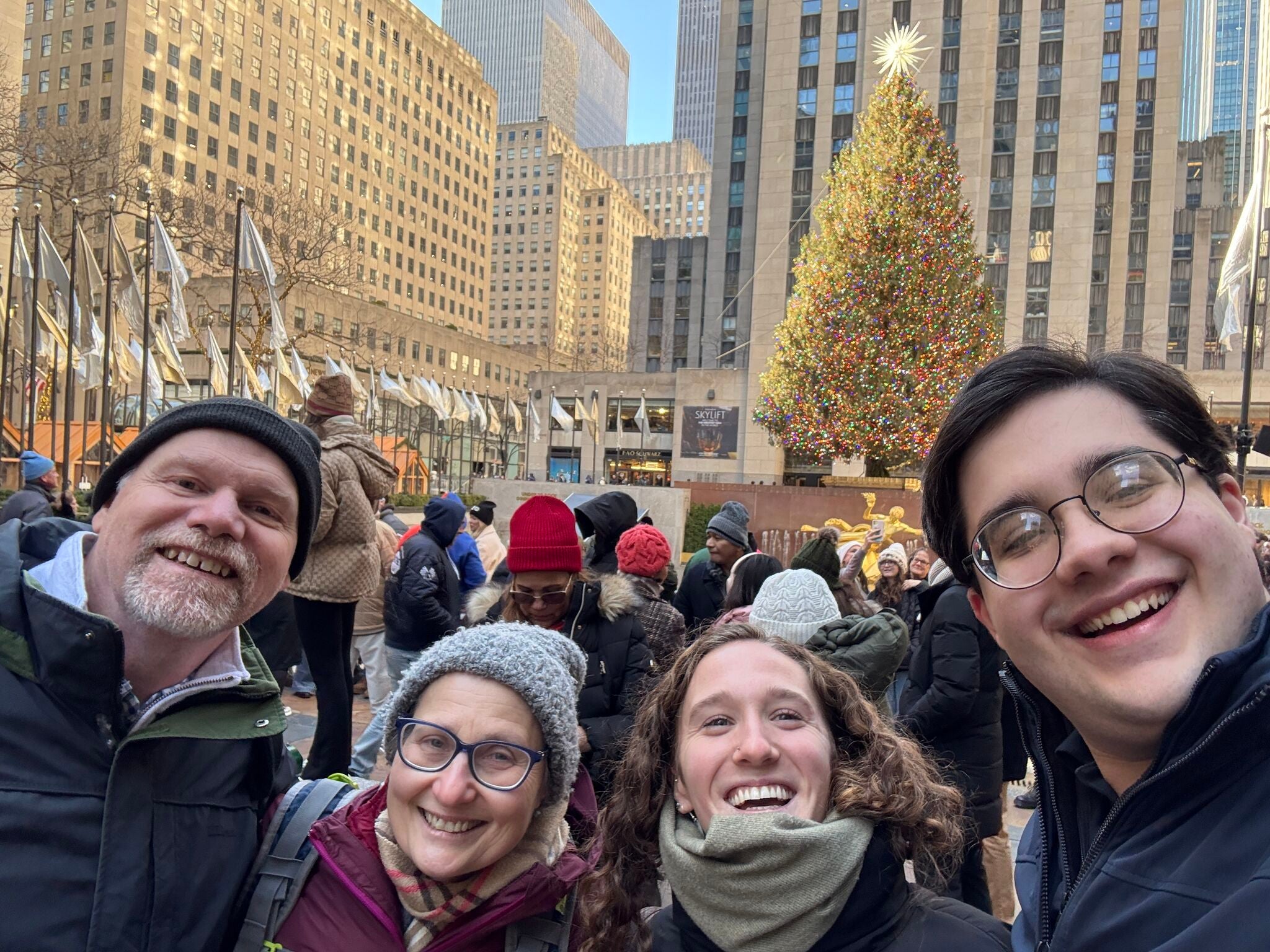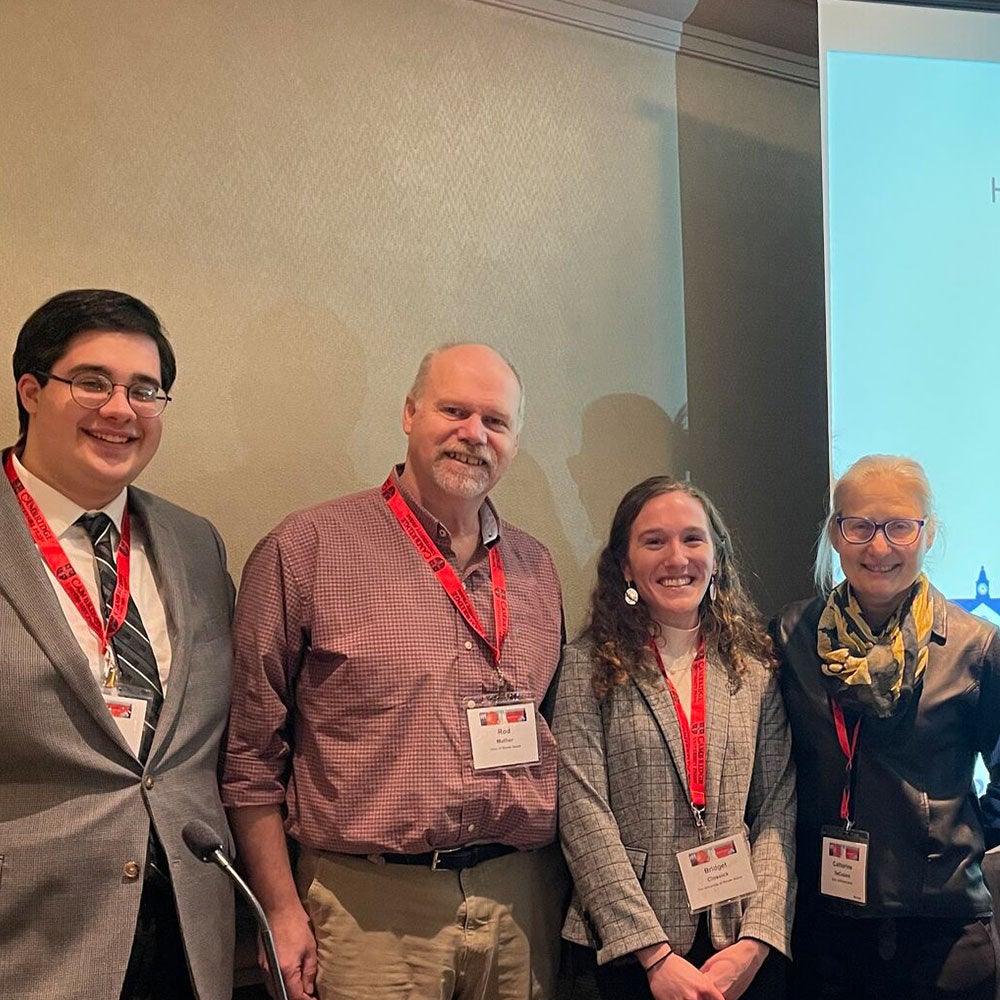NEW YORK CITY, NY – January 4, 2025 – The URI history department has a lot to be proud of after a successful weekend of presentations at the American Historical Association, with the support of Jen Riley, Dean of the College of Arts and Sciences, and RhodyNow. Since 1884, the American Historical Association annual meeting has been the premier gathering for historians to come together and share research and professional development, to learn about the discipline, and to network with other scholars from across the world.
Notoriously difficult to be selected to present work, the conference featured presentations from Catherine DeCesare and Rod Mather, both URI professors of history; and recently graduated students Bridget Clossick ‘24 and Dennis Haggerty ‘23. DeCesare and Mather shared their work on creating and building URI’s Applied History Program; Clossick presented her paper on school violence and American firearm policy; Haggerty spoke to his paper on pandemic preparedness. The white papers were the final product of the two-semester history capstone course (HIS 441 and 495) taught by Mather and DeCesare in the spring of 2023 and fall of 2023.
Since then, Clossick and Haggerty’s white papers have received numerous accolades. They were co-recipients of the URI Writing Award in the advocacy category and previously presented the papers at the New England Historical Association (NEHA) Spring 2024 Conference at St. Anselm’s College, NH. Their work caught the attention of the NEHA Executive Committee, which selected the URI Applied History panel to represent New England at the national conference. The student papers were also published on the] Applied History Lab website as examples of outstanding student work.
The Applied History Lab at URI exists to improve domestic public policy through the application of historical methods and enhanced contextual understanding.
The history capstone is the cornerstone of the history undergraduate degree at URI. The Applied History version of the capstone provides students with the opportunity to delve into a research topic, with an end product of a history and policy white paper and skills for the next step in their career.
The capstone project is spread out over two semesters and can be quite rigorous, explained Mather. The course changes depending on who is teaching it, as it often reflects the professor’s area of expertise. The students identify research projects in their first semester and develop a plan and prospectus for their own research. In their second semester, the students write their undergraduate thesis.
“It really showcases the strength of history as a major and the writing component of what we do. We proudly foster student success; many of the students that complete the applied history capstone have strong outcomes, and attending the AHA is an example. But there are other great results, too. We have a student, based on the strength of her white paper, who was accepted to Harvard,” said DeCesare.

Bridget Clossick’s, “A Call to Action: Addressing the Root Causes of American School Shootings” came out of trying to understand why the United States has seen a rapid escalation of school shootings since the start of the 21st century. Clossick approached her research by analyzing historical analogues, finding trends, and assessing current policy options. Through her research, she found that during periods when the U.S. faced internal threat and/or unrest, Congress enacted gun regulation in a politically unified manner.
For example, the 1930s, 1960s, and early 1990s America saw an increase in crime rate and deaths due to firearms. As a result, politicians came together and passed gun regulation. Today we have broken with that historical trend. Our country is experiencing a horrific rise in school shootings, and yet the political response is negligible.
“We are undergoing a major internal threat, yet there has been no legitimate political reaction,” said Clossick.
Dennis Haggerty’s, “Preparing for the Next Pandemic: U.S and Rhode Island Pandemic Preparedness” focuses on U.S. and Rhode Island pandemic preparedness and response, using historical analysis to inform policy recommendations. He examined three major pandemics: the Spanish Flu (1918-1920), the Asian Flu (1957-1958), and the Hong Kong Flu (1968-1969) – as analogues for understanding the COVID-19 pandemic and other contemporary public health challenges.
Haggerty found both similarities and differences across all four pandemics, and his applied historical analysis yielded crucial insights regarding the ineffectiveness of federal preparations and response, the decentralization of public health policy, and the importance of disease surveillance systems.
“I resolved that the question is when, not if, the next pandemic will occur, and both the federal government and the states must be ready,” explained Haggerty. “I summarily recommended four distinct policy prescriptions to strengthen pandemic preparedness and response policies.”
With the New England Historical Association and the American Historical Association under their belts at the beginning of their careers, the future is bright for these alumni. Haggerty continues his education as a Master of Public Administration graduate student at URI – the first accredited MPA program in the state. He plans to graduate in the fall of 2025. And Clossick is applying for the one-year visa so that she can move to Dublin this summer.
“We think they both did a fantastic job in their presentations,” said DeCesare. “Our panel was well received with positive feedback. Our students were eloquent, and they effectively answered questions from the historians in the audience, which can be intimidating for undergraduates or recent graduates. They really rose to the occasion.”
To learn more about the Applied History Lab and other opportunities in the department, reach out to Catherine DeCesare (cdecesare@uri.edu) or Rod Mather (rodmather@uri.edu)

